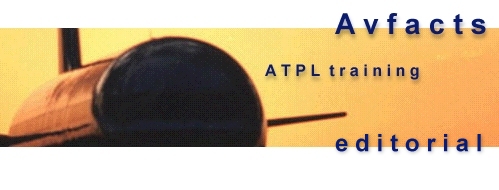




 |
 |
  |
 |
Performance & Navigation Topic 7.
Buffet Boundaries - Coffin Corner
|
General
High speed jet aircraft may suffer both high and low speed stall buffet. The high speed buffet is caused by flow separation from the wings as occurs behind a shockwave at high altitudes and/or Mach numbers. The low speed buffet is caused by the same airflow separation as the aircraft approaches the stall angle of attack. High speed aircraft flight manuals will have published in them at least 3 graphs called “Initial Buffet Boundary Charts”. One is for level flight and nil turbulence (ie: 1G manoeuvres), one for 40 degree bank angles/moderate turbulence (ie: 1.3G manoeuvres), and one for 50 degree bank angles/heavy turbulence (ie: 1.6G manoeuvres). As you are probably aware, low speed stall speeds are increased as angle of bank increases. The same is true as the degree if turbulence increases, effectively the aircraft weighs more in both cases (eg: 30% more in the case of moderate turbulence or 40 degree bank angles). Increased aircraft weight on it’s own also increases the low speed stall speed. The buffet boundary tables on pages 2-11, 2-12, and 2-13 are there for aircrew guidance in selecting a suitable flight level, given the atmospheric conditions forecast, or actually experienced. The turbulence penetration speeds are also displayed, along with maximum normal operation speeds as indicated airspeed (abbreviated VMO) up to FL335, and as a Mach number (abbreviated MMO) for flight levels over FL335. The Buffet Boundary charts in detail Page 2-11 of the B727 flight manual is for nil turbulence and level flight. Along the graphs vertical axis is the pressure altitude scale (FL), and along the bottom are the indicated airspeed values. The curved lines represent the aircraft weight in kgs x 1000, and range from 50, 000 kg to 90, 000 kg. You may be asked in the ATPL exam to identify the values of low speed aerodynamic buffet, and high speed aerodynamic buffet. Example: What is the low and high speed buffet speeds expressed as an IAS if the aircraft gross weight is 80, 000 kg, and the aircraft is at FL310, assuming MODERATE turbulence ? Refer to Figure Buffet 1 below.
This mini training editorial is a preview from the recently released online course on ATPL Performance and Load. It is now available book form and via the internet. Both course include assignments/answers/practice exams/helpline.
Click here
for more information on the Performance and Load
course delivered via the Internet.
Click here
for more information on the Flight Planning course
delivered via the Internet.
Click here for
more information on the Navigation course delivered via the
Internet.
Click here for
more information on ATPL courses available.
|
